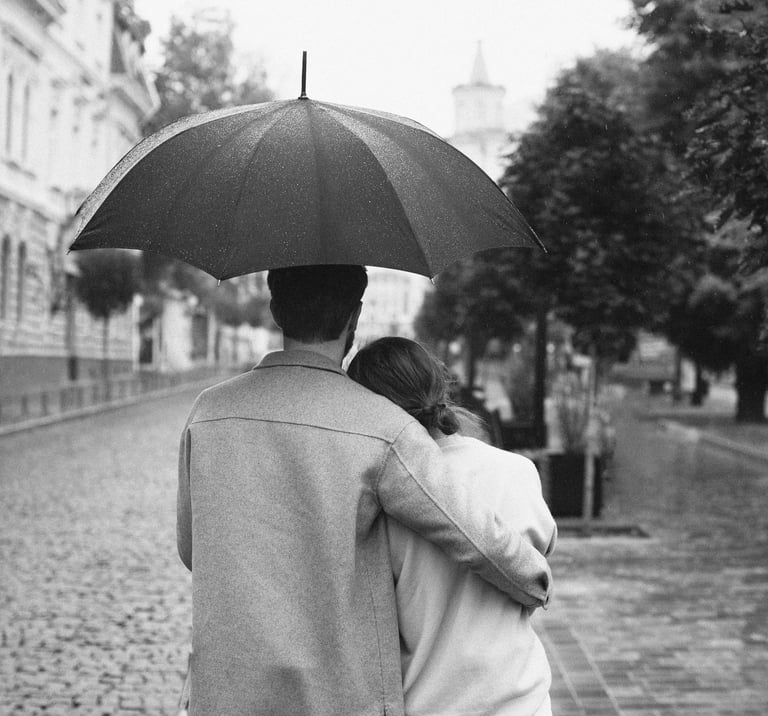Street Photography in Extreme Weather: Beyond the Ordinary
When The Elements Shape The Streets
Street photography is often associated with capturing everyday moments, spontaneous interactions, and fleeting glimpses of life in urban spaces. But what happens when the weather shifts from the mundane to the extraordinary? Extreme weather—whether it’s rain, snow, fog, or even blistering heat—has a way of transforming the familiar into something entirely new. For a street photographer, these moments offer both unique challenges and unparalleled opportunities to capture something extraordinary.
The Magic of Rain: Reflections and Drama
Rain transforms the streets into a shimmering canvas, offering photographers a new way to engage with their surroundings. The wet pavement reflects buildings, people, and lights, creating a dynamic, mirror-like surface that adds layers of depth to any scene. Raindrops on windows, umbrellas, and wet clothing all tell a story about the city’s mood. But beyond reflections, rain adds a certain drama—people hurrying under umbrellas, puddles forming, the blur of headlights in the misty air. The combination of motion and reflection makes rainy days a street photographer’s playground.
Capturing the right moment in the rain, however, requires patience and preparedness. A camera’s exposure needs to be carefully balanced to avoid overexposing light reflections or losing details in dark, wet surfaces. Keeping gear dry is another practical challenge, but those who are prepared can transform a rain-soaked street into a visual symphony of light and texture.


Fog: The Mysterious Veil of the Streets
Fog transforms the streets into something out of a dream—a soft, hazy world where outlines blur and the familiar becomes shrouded in mystery. Fog has the magical ability to simplify a scene, isolating shapes and figures, and leaving just enough visible to invite the viewer’s imagination to fill in the blanks.
Street photographers can use fog to create a sense of mystery and intrigue, where the background fades away, and only the immediate subject is left in sharp focus. Figures walking through misty streets appear almost ghostly, while streetlights and traffic lights take on an eerie glow. It’s as if the city is holding its breath, waiting for the fog to lift.
Foggy conditions allow for interesting play with light and shadow. Backlit subjects, with fog diffusing the light, can produce ethereal images that wouldn’t be possible in clear weather. The challenge lies in timing—fog can lift unexpectedly, so being ready to capture fleeting moments is key. Photographers may also need to experiment with focusing, as fog can confuse autofocus systems, requiring manual adjustments to keep subjects sharp.
The Stillness of Snow: Isolation and Contrast
Snow brings a quiet stillness to the streets, muffling the usual sounds of urban life and slowing everything down. In street photography, snow offers a chance to focus on contrast—the bright whiteness of the snow against dark buildings, the slow, deliberate movements of people trying to navigate icy sidewalks. The street becomes a minimalist’s dream, with clean lines and stark contrasts that evoke a sense of solitude.
In cities that rarely experience snow, the appearance of snowfall brings about a sense of novelty and curiosity. People’s reactions to snow—whether joyful or frustrated—are often opportunities for capturing human emotion in a different light. Snow-covered cars, empty park benches, and footprints trailing through the whiteness all create visual stories about the city’s temporary transformation.
Photographers must pay careful attention to exposure in snow, as it can be easy to overexpose the bright surfaces. Underexposing slightly can help maintain details and texture in the snow, making for striking images that capture the cold stillness and beauty of a snow-covered city.
Blistering Heat: The Urban Mirage
Shooting street photography in extreme heat presents a different challenge altogether. Hot days can change the way people move and interact with the environment—pedestrians seek shade, slow their pace, and find ways to cool down. In such conditions, photographers have the opportunity to capture moments of adaptation: people huddling under awnings, sweating through their clothes, fanning themselves with newspapers.
Heat creates optical illusions too—waves of heat rising from the pavement, blurring distant figures in a mirage-like haze. These distortions can add a surreal, almost otherworldly effect to street photographs, giving the impression that the city itself is melting under the sun.
However, extreme heat requires photographers to be cautious. Both the photographer and the camera equipment can be affected by high temperatures, and heat exhaustion is a real concern when shooting for extended periods. Hydration, sun protection, and managing the heat are as important as framing the perfect shot.
Lightning Storms: The Drama of Nature
For those lucky enough to experience a storm with lightning in an urban setting, the opportunity for dramatic, high-contrast imagery is immense. Lightning streaking across the sky, illuminating skyscrapers, or reflecting in puddles can create awe-inspiring shots that merge the raw power of nature with the grit of the streets. The challenge lies in the unpredictability of storms and the difficulty of timing the shot perfectly to catch a lightning strike.
A tripod is often essential for long exposures during storms, and photographers need to ensure their gear is protected from the rain. The results, though, can be breathtaking, as lightning gives life to the city’s skyline in a way no other natural event can.
The Payoff: Capturing the Extraordinary
The true reward of street photography in extreme weather is in capturing the extraordinary within the ordinary. Weather forces people to interact with their environment differently, and it transforms the streets into a stage where unexpected moments unfold. These moments are often imbued with more drama, emotion, and depth than a sunny, clear day might offer.
When rain falls, when snow blankets the city, when fog rolls in or heat ripples off the pavement, street photographers are gifted with a rare opportunity to see the city in a different light—sometimes literally. Extreme weather is the lens through which we can glimpse the extraordinary, even in the most familiar places.
So the next time the sky turns grey, or the temperature drops, grab your camera, step outside, and embrace the elements. You might just capture a moment of beauty, humour, or serenity that only exists in the in-between spaces of weather and time.
The Challenge of Preparedness
Extreme weather in street photography is all about preparation. While some photographers may carry protective gear, waterproof bags, and lens hoods to brave the elements, others find improvising part of the fun. What’s crucial, however, is knowing your limits—both as a photographer and in terms of equipment.
Cameras and lenses can suffer from moisture, heat, and cold, so it’s important to safeguard your gear. But the biggest challenge is often psychological—street photography in extreme weather requires dedication and perseverance. The results, though, can be well worth it. Capturing a unique, weather-altered scene is like bottling a fleeting piece of the world—a moment of transformation that may never come again.
Copyright © 2025 Peter Pickering. All Rights Reserved. All Wrongs Reversed.
🌐 peterpickering.com | 🎺 sessionsonthegreen.com | 💜 isaacbcole.com | ▶️ YouTube Channel | 🌿 life.peterpickering.com


